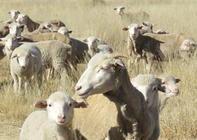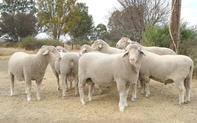Dual-purpose sheep breeds in South Africa refers to an animal that can be farmed for both the production of wool and meat. South African studies have found that farming with a suitable dual-purpose breed for a specific climate can generate a higher income than farming with a meat-only breed.

South African Mutton Merino
However, many parameters play a role, not least how each breed reacts to climate conditions such as drought.
Therefore it is important to choose the right breed to adapt to current farming conditions and weather patterns. A few of the most important dual-purpose breeds in South Africa are listed below.
The dual-purpose Merino is also called the German Merino and was used to develop other sheep breeds such as the Dormer and Dohne Merino. Through breeding and selection, this breed is now considered uniquely South African.
This large sheep produces both meat and good quality medium to strong wool of 21 - 23 micron. Although initially developed to utilise winter grazing in the Western Cape and rear their lambs before grazing deteriorates in summer, the mutton Merino adapts well to a range of climates and is found countrywide.
It has a high resistance to internal parasites such as hairworm and is less susceptible to diseases such as Johne’s disease. The age of first lambing is 22 months. The mutton Merino’s 100-day weights are 29 kg for ewes and 32 kg for rams. The mutton Merino puts on fat when older and can, therefore, be slaughtered at a heavier live weight. Carcasses have an even fat distribution.
Merino Landsheep

The first Merino Landsheep was imported from Germany in 1956 and quickly adapted to South Africa’s grazing conditions and climate. The Landsheep has a very long and deep body, producing heavy lamb carcasses of 20 - 25 kg at 100 to 120 days with an above average slaughter percentage of around 54%.
The breed is fertile and can produce three lambs every two years with first lambing at 12 - 15 months. Lambs are small at birth with very few birthing problems. The Merino Landsheep produce a good crop of medium to strong wool.
Dormer Sheep
The Dormer meat sheep was ‘developed’ in South Africa through crossbreeding Dorset Horn rams with German Merino ewes. The name ‘Dormer’ refers to the parent breeds Dorset and Merino. It was specifically bred for the cold and wet conditions of the winter rainfall areas of the Western Cape but is farmed successfully in temperate conditions on natural veld and cultivated pastures.
The Dormer produces strong white wool of average 27 microns. The well-muscled sheep shows early maturity age - first lambing is 18 months - and is very fertile; producing small, multiple lambs. The fast-growing breed exhibits a good feed conversion rate to produce slaughter-size lambs at an early age - lambs can be market-ready at three months, weighing 16 - 22 kg. The Dormer is resistant to the Muellerius lungworm.
Dohne Merino Sheep
The Dohne Merino sheep was developed from crossing South African Mutton Merino rams with Merino ewes to adapt to the sour grass veld areas in the Eastern Cape. Since the development of the breed in 1939, embryos of the Dohne have been exported to establish breeder societies in Australia and Uruguay.
A dual-purpose breed, the hornless white Dohne produces meat and fine to medium wool.
Dohne lambs can achieve a slaughter weight of 40 kg in 4 to 6 months. The Dohne’s 100-day weaning weights are 29.9 kg for ewes and 31.1 kg for rams.
Afrino Sheep
A locally-developed dual-purpose sheep breed, the Afrino has 25% Merino, 25% Ronderib Afrikaner and 50% SA Mutton Merino as its ancestors. It was developed as a wool-producing sheep, suitable for extensive farming conditions with an early maturity for slaughter lamb production.
The Afrino is a large breed with wool of 18 - 22 microns which can contribute 20% of income; the rest is from meat production. The age of first lambing is about 17 months and the average marketing age (42 kg) is achieved in 7 to 9 months under veld grazing conditions. Afrinos do well in feedlot farming systems as feed is converted to muscle rather than fat.
Suffolk Sheep
The Suffolk sheep is a polled (hornless) English sheep breed that was brought to South Africa in the late 1890s. Some considered the Suffolk a meat breed but is also used for wool production.
A large muscular breed with black head and black legs, the sheep produces a carcass with a good ratio of lean meat and fat, but they also produce medium wool. Suffolks experience easy births, but rarely produce twins. Suffolk rams are often used for crossbreeding and produce heavy early-maturing lambs that can be market-ready in just over 2 months.
By Marinda Louw